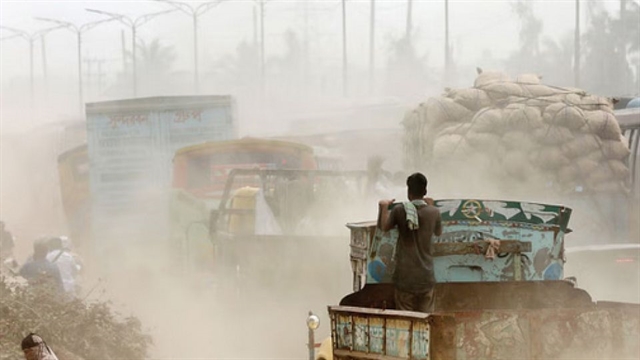 World
World


|
| Bangladesh's Department of Environment has started making public the state of the air quality and is recommending action when it is at unacceptable levels. — The Daily Star/ANN |
DHAKA — Bangladesh’s air was the worst in the world last year and it was 15 times worse than the minimum set by the World Health Organisation guideline.
According to the World Air Quality Report 2023, Bangladesh recorded an annual average PM2.5 concentration of 79.9 µg/m3.
PM2.5, or particulate matter 2.5, refers to fine particles or droplets in the air that are 2.5 microns or less in width. Particulate matter 2.5 has been linked to asthma, heart and lung disease, cancer, and other respiratory illnesses. It is said to affect the cognitive abilities of children and complicate existing diseases like diabetes.
Bangladesh ranked number one among countries and territories with the highest average amount of PM2.5 in the air, according to the report.
Researchers from IQAir, a Swiss air quality tech company, analysed pollution data from 7,812 locations in 134 countries, territories, and regions, specifically measuring PM2.5.
Saber Hossain Chowdhury, minister for environment, forests and climate change, told The Daily Star, “We all know how grave and critical the air quality situation is and we did not get here in one day. There can be no overnight fixes but now that we have identified the sources of the pollution, have acknowledged the problem, and have been honest and upfront about it, I think we are now headed in the right direction.”
He said the Department of Environment has started making public the state of the air quality and is recommending action when it is at unacceptable levels.
The World Air Quality Report 2023 said Dhaka’s air had more than 16 times the PM2.5 permissible under the WHO’s annual guideline.
“The city’s concentration increased over 20 percent from 2022’s mark of 65.8 µg/m3. There were four months in 2023 where the monthly concentration averages were above 100 µg/m3 and two months where the average breached 150 µg/m3,” the report said, adding that Dhaka ranked second worst among capital cities.
Brick kilns, vehicle emissions, dust, emissions from factories, household cookstoves, plastic incineration, and unlined landfills are the key sources of air pollution in Bangladesh.
“Air pollution in northern South Asia can be transboundary in nature, as pollutants converge and drift across the shared Indo-Gangetic Plain. Smoke from countries, including India, Nepal, and Pakistan, can drift into Bangladesh during crop burning season,” the report said.
Central and South Asia were the worst-performing regions globally. South Asia is of particular concern, with 29 of the 30 globally most polluted cities being located in India, Pakistan and Bangladesh.
Only 10 countries and territories had better air quality than they had in 2022: Finland, Estonia, Puerto Rico, Australia, New Zealand, Bermuda, Grenada, Iceland, Mauritius, and French Polynesia.
Experts said the air quality situation in Bangladesh was gradually worsening and the issue should get top priority considering the health impact.
Prof Abdus Salam, of Dhaka University’s Chemistry department, told The Daily Star yesterday, “Various studies have shown that many parts of the country, especially the urban areas, are no longer liveable at all. Over the years, Bangladesh has shown huge progress according to many indicators but when it comes to air quality, we are going in the opposite direction.”
The air quality expert said Bangladesh should take long-term steps to improve air quality and this sector needs well-thought-out investments.
According to the WHO, air pollution is the greatest environmental threat to human health as it causes an estimated one in every nine deaths worldwide and is responsible for an estimated seven million premature deaths across the globe every year.
Prof Abul Bashar Mohammad Khurshid Alam, director general of the Directorate General of Health Services (DGHS), said, “Due to poor air quality, the number of patients with asthma and respiratory diseases is increasing in urban areas. Children are the worst victims and we are also noticing allergic manifestation in the adults.”
He, however, said industrial air pollution is more lethal than street air pollution as carcinogenic elements are present in industrial air pollution.
PM2.5
The report said while PM2.5 poses direct health risks, its implications extend beyond human health to complex environmental processes impacted by the Earth’s climate.
It said climate change, primarily driven by greenhouse gas emissions, plays a pivotal role in influencing concentrations of PM2.5 air pollutants, and fossil fuel emissions are simultaneously responsible for the majority of PM2.5-related deaths.
Fossil fuel emissions account for 65 per cent of global CO2 emissions and are also the primary cause of the majority of PM2.5-related deaths, highlighting the interconnected relationship between air quality and climate change, the report finds.
“A clean, healthy, and sustainable environment is a universal human right. In many parts of the world the lack of air quality data delays decisive action and perpetuates unnecessary human suffering. Air quality data saves lives. Where air quality is reported, action is taken, and air quality improves,” states Frank Hammes, Global CEO, IQAir. — The Daily Star/ANN




